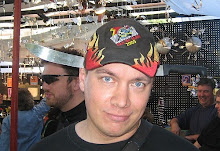
(kuva 06) Sumun peittämän Big Surin rannikkokaistaleen jälkeen käännyimme sisämaahan, ja kävimme Montereyn lähellä kurkkaamassa Laguna Secan legendaarista kilparataa. Ylitimme pannukakkumaisen tasaisen Central Valleyn, jossa lämpötila oli lähemmäs 40C varjossa, ja nousimme Sierra Nevadan vuorille, valiten pariksi yöksi ´tukikohdaksemme´ pienen Mariposan kaupungin (nimi tarkoittaa perhosta espanjaksi). Muutamat vanhat rakennukset sen keskustassa olivat kuin Villin lännen elokuvasta ja upeat, mutkaiset tiet korkeiden metsien keskellä veivät Yosemiten kansallispuistoon. Kuvassa näköala Glacier Pointin näköalapaikalta vasemmalla olevaan Yosemiten laaksoon; takana näkyy Half Domen pystyjyrkkä graniittikallio, joka nousee laaksonpohjalta yli 1400 metriä. Tämä vuodenaika tosin ei ollut paras esim. vesiputousten näkemiseen. Kävimme katsomassa myös valtavia, parhaimmillaan yli 100-metrisiksi kasvavia sequioa-puita, joiden pudonneita jättikäpyjä oravat kävivät nakertamassa. Isompiakin villieläimiä puistossa elää, mutta nämä pysyttelivät varmaankin helteestä johtuen piilossa.
(picture 06) We rode through Big Sur in the coast, but it was thoroughly covered in fog, so went inland near Monterey, and checked out the legendary Laguna Seca racetrack. Then we crossed the totally flat Central Valley, where temperature was close to 100F in shade. We went to the Sierra Nevada mountains, and chose the small town of Mariposa (spanish for butterfly) as our ´base´ for a couple of nights. Some old buildings at the center of town were like they´re taken out of a Wild West film, and from there fabulous mountain roads, curving inside high forests led to Yosemite National Park. Here is a view from Glacier Point viewing area to the Yosemite Valley on the left. On the back is the vertical Half Dome granite cliff, which rises 4700 ft from the valley floor. Our timing, however, was not the best for waterfalls. We also went to see the huge sequoia-trees, that can grow to be over 300 ft high. Many squirrels were eating the huge cones, that had dropped off from the trees. There is bigger wildlife in the park, too, but maybe because of the heat, they stayed out of view.

(kuva 07) Saavuimme San Franciscoon idästä Bay Bridgen kautta, ja sillalta (jonne ei ruuhkan takia valitettavasti voinut pysähtyä kuvaamaan!) avautui huikea näköala kaupungin keskustaan ja San Franciscon lahdelle. Kävimme ihmisiä ja kulttuuria kuhisevalla Fisherman´s Wharfin alueella, ja näimme myös kaupungin kuuluisia raitiovaunuja, jotka nousevat ja laskevat sen huiman jyrkkiä mäkiä. Kuvasta ei muuten havaitse ollenkaan sitä, kuinka jyrkkiä mäet ovat. Katso kauempana näkyvää osaa tiestä - itse asiassa jopa se nousee rannasta hieman! Taustalla jo varsin tutuksi käynyttä sumua San Franciscon lahdella, jossa keskellä näkyy maailmankuulu Alcatrazin vankilasaari.
(picture 07) We arrived in San Francisco from the east through Bay Bridge, which offered stupendous views of the city as well as the Bay Area, but unfortunately due to traffic, it was impossible to stop for any photos. We visited the Fisherman´s Wharf area, full of people and lively culture, and also saw the famous trams, that go up and down the city´s extremely steep hills. From this photo, you cannot really see, how steep they actually are. Look at the part of the road, that´s closest to the water - even that part actually rises a little! In the background, some of the fog, that we´d already become accustomed to, in the San Francisco Bay, where in the middle you can see the famous prison island of Alcatraz.

(kuva 08) Poistuimme San Franciscosta pohjoiseen maailman ehkäpä kuuluisinta siltaa, Golden Gate Bridgeä, joka ei tähän suuntaan mennessä ollut maksullinen. Tämä vuonna 1937 valmistunut rakennelma on vaikuttavan kokoinen; merenpinnasta 230 metriä korkea, ja kaikkiaan 2,7 kilometriä pitkä. Sen kaksi päävaijeria, jotka kannattelevat valtaosaa painosta, kumpikin on halkaisijaltaan lähes metrin, ja koostuu yli 27000 yksittäisestä teräsvaijerista. Pelkät sillan kannatintornit painavat kumpikin yli 40 miljoonaa kiloa! Kuva on pohjoispään näköalapaikalta, joka oli (kuten siltakin) täysin sumun peitossa vielä silloin, kun saavuimme paikalle, mutta onnekkaasti sumu haihtui kokonaan seuraavan vartin aikana, paljastaen paitsi sillan, myös San Franciscon keskustan lahden toisella puolen.
(picture 08) We exited San Francisco to the north, across the world-famous Golden Gate Bridge, which didnt have a road toll going this way. Opened in 1937, it is an impressive construction, rising 230 meters from sea level, and with a total length of 2,7 kilometers. The two main wires, that carry most of the weight, both have a diameter of nearly 1 meter, and inside of both are over 27000 separate steel wires. Only the bridges´ main towers (that there are two of) weigh over 40 million kilograms each! This photo is from the north end viewing area, which (like the bridge itself), was totally covered in fog, when we arrived. Luckily, all fog lifted during the next 15 minutes, revealing this magnificent bridge, as well as San Francisco downtown across the bay.

(kuva 09_a) Kalifornian osavaltion lipussa on kuvattuna karhu.
(picture 09_a) A bear appears in the California state flag.

(kuva 09_b) Luontoaiheinen kysymys: bongasimme Kalifornian pohjoisrannikolla olevasta jokisuusta (joka oli ainakin tähän vuoroveden aikaan erossa merestä eli todennäköisesti makeaa vettä) näin erikoisen näköisiä ´tuubeja´, joita oli näkyvillä ainakin 30, ja ne eivät liikkuneet, muttemme usko niiden olevan ihmisen tekeleitä. Kaikenlaiset ideat siitä, mitä ne ovat, otetaan ilolla vastaan!
(picture 09_b) A nature question: we saw these weird-looking ´tubes´ on the water on a river estuary, that wasnt (at least at that time) connected to the sea, so it was probably fresh water. There were about 30 of these visible, and they did not move, but we dont think they are man-made. So any ideas as to what these might be, would be warmly appreciated!

Ei kommentteja:
Lähetä kommentti